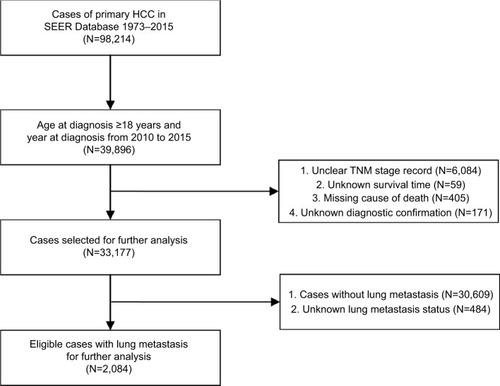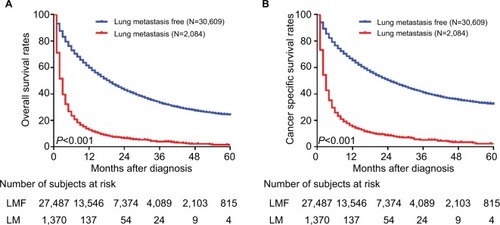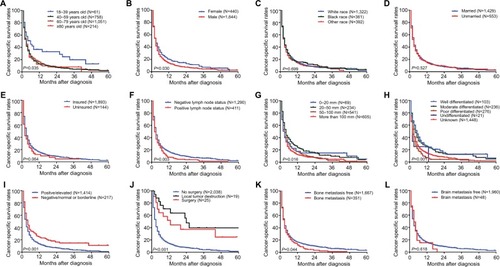Figures & data
Figure 1 Flowchart of the enrolled patients in the study according to inclusion and exclusion criterion.
Abbreviations: HCC, hepatocellular carcinoma; SEER, Surveillance, Epidemiology, and End Results.

Table 1 Baseline clinical demographics and multivariable logistic regression for analyzing risk factor for initial lung metastasis of primary hepatocellular carcinoma patients in SEER database (2010–2015)
Figure 2 Kaplan–Meier analysis of (A) overall survival and (B) cancer-specific survival in hepatocellular carcinoma patients with or without initial lung metastasis.
Abbreviations: LM, lung metastasis; LMF, lung metastasis free.

Figure 3 Kaplan–Meier analysis of overall survival in hepatocellular carcinoma patients with initial lung metastasis stratified by (A) age at diagnosis, (B) gender, (C) race, (D) marital status at diagnosis, (E) insurance status at diagnosis, (F) lymph node status, (G) maximum primary tumor size, (H) primary tumor differential grade, (I) alpha-fetoprotein level, (J) surgery for primary tumor, (K) bone metastasis, and (L) brain metastasis.

Figure 4 Kaplan–Meier analysis of cancer-specific survival in hepatocellular carcinoma patients with initial lung metastasis stratified by (A) age at diagnosis, (B) gender, (C) race, (D) marital status at diagnosis, (E) insurance status at diagnosis, (F) lymph node status, (G) maximum primary tumor size, (H) primary tumor differential grade, (I) alpha-fetoprotein level, (J) surgery for primary tumor, (K) bone metastasis, and (L) brain metastasis.

Table 2 Univariate and multivariate analysis of overall survival in patients with primary hepatocellular carcinoma lung metastasis in SEER database (2010–2015)
Table 3 Univariate and multivariate analysis of cancer-specific survival in patients with primary hepatocellular carcinoma lung metastasis in SEER database (2010–2015)
